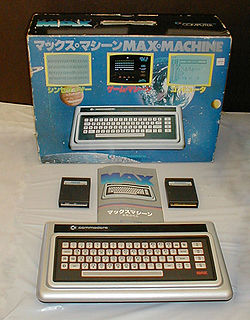Commodore MAX Machine
 | |
| Type | Console / Home computer |
|---|---|
| Release date | 1982 |
| Discontinued | 1982 |
| Operating system | MAX BASIC (Cartridge) |
| CPU | MOS Technology 6510 @ 1.02 MHz |
| Memory | 2.0 KB, 0.5 KB color RAM |
| Graphics | VIC-II 6566 (320 x 200, 16 colors, sprites, raster interrupt) |
| Predecessor | Commodore VIC-20 |
| Successor | Commodore 64 |
The Commodore MAX Machine, also known as Ultimax in the United States and Canada and VC-10 in Germany, is a home computer designed and sold by Commodore International in Japan, beginning in early 1982, a predecessor to the popular Commodore 64.[1] The Commodore 64 manual mentions the machine by name, suggesting that Commodore intended to sell the machine internationally; however, it is unclear whether the machine was ever actually sold outside Japan. When it was officially presented, in Tokyo, for the first time, it was named Commodore VICKEY. It is considered a rarity.
Software was loaded from plug-in cartridges and the unit had a membrane keyboard and 2.0 KiB of RAM internally and 0.5 KiB of color RAM (1024 × 4 bits). It used a television set for a display. It used the same chipset and 6510 CPU as the Commodore 64, the same SID sound chip, and compatible ROM cartridge architecture so that MAX cartridges will work in the C-64. The MAX compatibility mode in C-64 was later frequently used for "freezer" cartridges (such as the Action Replay), as a convenient way to take control of the currently running program.[2][3] It was possible to use a tape drive for storage, but it lacked the serial and user ports necessary to connect a disk drive, printer, or modem.[3]

It was intended to sell for around 200 USD. Although the MAX had better graphics and sound capability, Commodore's own VIC-20, which sold for around the same amount of money, was much more expandable, had a much larger software library, and had a better keyboard—all of which made it more attractive to consumers.
Unlike the C-64, the MAX never sold well and was quickly discontinued.
See also[]
References[]
- ^ "OLD-COMPUTERS.COM : The Museum". www.old-computers.com. Archived from the original on 2021-08-19. Retrieved 2022-01-22.
- ^ "The Ultimax/Max Machine, The 64GS, The 64CGS". The Secret Weapons of Commodore. 2018-01-21. Retrieved 2019-01-12.
- ^ a b "Commodore MAX - Computer - Computing History". www.computinghistory.org.uk. Archived from the original on 2021-06-23. Retrieved 2022-01-22.
External links[]
- Commodore MAX Machine / Ultimax at the Wayback Machine (archived 6 November 2014)
- The UltiMax machine (a.k.a. VIC-10)
- The MAX Machine, the odd one out
| Wikimedia Commons has media related to Commodore MAX Machine. |
- 6502-based home computers
- Commodore 64
- Products introduced in 1982